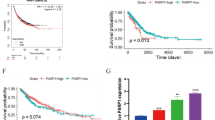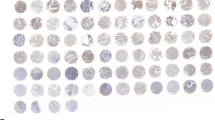Objective
To explore the role of CARM1 in lung cancer (LC) and its relationship with TP53 and CTNNB1.
Methods
Lung cells H1299 and PC14 were randomly divided into six groups: ov-H1299, si-H1299, ov-PC14, si-PC14, Con-H1299, and Con-PC14. Transwell assay, plate clone formation assay, and flow cytometry were used to determine the migration, clone formation capacity, and apoptosis situation of LC cells in the six groups, respectively. Western blot assay was used to determine the protein expression of CARM1, TP53, and CTNNB1 in the six groups. CHIP assay was applied to analyze the combined characteristics of JUN and TP53 promoter. Co-immunoprecipitation was used to analyze the interaction between TP53 and CARM1/CTNNB1. Cox proportional hazard regression model was used to analyze the relevance between the expression of CARM1 and clinicopathological information of the patient. Kaplan−Meier plot was used to determine the relevance between CARM1 and patient survival.
Results
High expression of CARM1 inhibits the migration and proliferation of LC cells and promoted the apoptosis of LC cell. Overexpression of CARM1 promotes the expression of CARM1 and TP53, while decreases CTNNB1 expression. CARM1 supplementation of H1299 cells induced JUN aggregation on the TP53 promoter. TP53 and CARM1 protein/TP53 and CTNNB1 protein in H1299 cells were immunoprecipitated together. High expression of CARM1was negatively correlated with the degree of tumor metastasis. The survival period of patients with high expression CARM1 was greater than that of low expression.
Conclusion
Overexpression of CARM1 may inhibit the progression of LC by targeting TP53 via regulation CTNNB1.






Similar content being viewed by others
References
Siegel RL, Miller KD, Jemal A (2015) Cancer statistics, 2015. CA Cancer J Clin 65:5–29. https://doi.org/10.3322/caac.21254
Miranda TB, Miranda M, Frankel A, Clarke S (2004) PRMT7 Is a member of the protein arginine methyltransferase family with a distinct substrate specificity. J Biol Chem 279:22902–22907. https://doi.org/10.1074/jbc.M312904200
Elakoum R, Gauchotte G, Oussalah A et al (2014) CARM1 and PRMT1 are dysregulated in lung cancer without hierarchical features. Biochimie 97:210–218. https://doi.org/10.1016/j.biochi.2013.10.021
An W, Kim J, Roeder RG (2004) Ordered cooperative functions of PRMT1, p300, and CARM1 in transcriptional activation by p53. Cell 117:735–748. https://doi.org/10.1016/j.cell.2004.05.009
Cheng H, Qin Y, Fan H et al (2013) Overexpression of CARM1 in breast cancer is correlated with poorly characterized clinicopathologic parameters and molecular subtypes. Diagn Pathol 8:129. https://doi.org/10.1186/1746-1596-8-129
Li P, Yao H, Zhang Z et al (2008) Regulation of p53 target gene expression by peptidylarginine deiminase 4. Mol Cell Biol 28:4745–4758. https://doi.org/10.1128/MCB.01747-07
Green DR, Kroemer G (2009) Cytoplasmic functions of the tumour suppressor p53. Nature 458:1127–1130. https://doi.org/10.1038/nature07986
Pfister NT, Prives C (2016) Chromatin dysregulation by mutant p53. Oncotarget 7:29875–29876. https://doi.org/10.18632/oncotarget.7922
Bulzico D, Torres DC, Ferreira GM et al (2017) A novel TP53 mutation associated with TWIST1 and SIP1 expression in an aggressive adrenocortical carcinoma. Endocr Pathol 28:326–331. https://doi.org/10.1007/s12022-017-9482-7
Cho S-Y, Park C, Na D et al (2017) High prevalence of TP53 mutations is associated with poor survival and an EMT signature in gliosarcoma patients. Exp Mol Med 49:e317. https://doi.org/10.1038/emm.2017.9
Saccani S, Natoli G (2002) Dynamic changes in histone H3 Lys 9 methylation occurring at tightly regulated inducible inflammatory genes. Genes Dev 16:2219–2224. https://doi.org/10.1101/gad.232502
Jemal A, Bray F, Center MM et al (2011) Global cancer statistics. CA Cancer J Clin 61:69–90. https://doi.org/10.3322/caac.20107
Marchevsky AM, Gal AA, Shah S, Koss MN (2001) Morphometry confirms the presence of considerable nuclear size overlap between “small cells” and “large cells” in high-grade pulmonary neuroendocrine neoplasms. Am J Clin Pathol 116:466–472. https://doi.org/10.1309/H40B-8W14-4Q47-03EP
Fassina A, Cappellesso R, Fassan M (2011) Classification of non-small cell lung carcinoma in transthoracic needle specimens using microRNA expression profiling. Chest 140:1305–1311. https://doi.org/10.1378/chest.11-0708
Chen D, Ma H, Hong H et al (1999) Regulation of transcription by a protein methyltransferase. Science 284:2174–2177. https://doi.org/10.1126/science.284.5423.2174
Lee Y-H, Koh SS, Zhang X et al (2002) Synergy among nuclear receptor coactivators: selective requirement for protein methyltransferase and acetyltransferase activities. Mol Cell Biol 22:3621–3632. https://doi.org/10.1128/MCB.22.11.3621-3632.2002
Messaoudi SE, Fabbrizio E, Rodriguez C et al (2006) Coactivator-associated arginine methyltransferase 1 (CARM1) is a positive regulator of the Cyclin E1 gene. PNAS 103:13351–13356. https://doi.org/10.1073/pnas.0605692103
Petitjean A, Achatz MIW, Borresen-Dale AL et al (2007) TP53 mutations in human cancers: functional selection and impact on cancer prognosis and outcomes. Oncogene 26:2157–2165. https://doi.org/10.1038/sj.onc.1210302
Shishkova E, Zeng H, Liu F et al (2017) Global mapping of CARM1 substrates defines enzyme specificity and substrate recognition. Nat Commun 8:15571. https://doi.org/10.1038/ncomms15571
Acknowledgements
This work was supported by Longhua Hospital Affiliated to Shanghai University of Traditional Chinese Medicine, Dragon Medical Scholars (Nursery Program) of National Clinical Research Base of Traditional Chinese Medicine (No. LYTD-82) and the Zhoushan Traditional Chinese Medicine Hospital, Zhoushan Science and Technology Project (No. 2015C31036).
Author information
Authors and Affiliations
Corresponding author
Ethics declarations
Conflict of interest
The authors declare that they have no conflict of interest.
Additional information
Publisher's Note
Springer Nature remains neutral with regard to jurisdictional claims in published maps and institutional affiliations.
Rights and permissions
About this article
Cite this article
Hu, B., Li, X., Chen, L. et al. High Expression of CARM1 Inhibits Lung Cancer Progression by Targeting TP53 by Regulating CTNNB1. Lung 198, 415–422 (2020). https://doi.org/10.1007/s00408-020-00324-7
Received:
Accepted:
Published:
Issue Date:
DOI: https://doi.org/10.1007/s00408-020-00324-7




